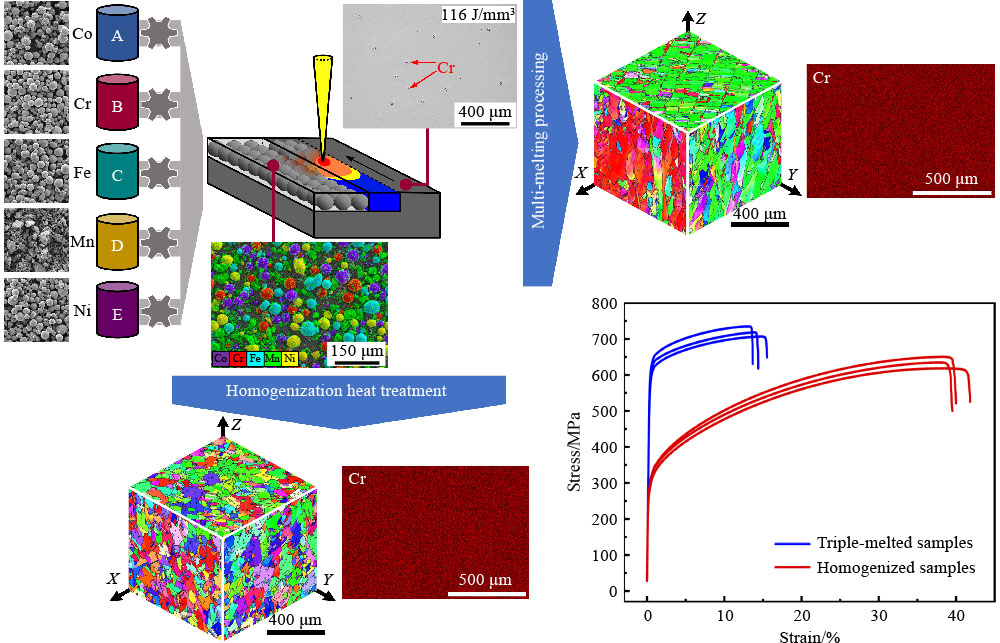Additive manufacturing (AM) is an emerging and ever-developing technology wherein solid parts are formed by accumulating materials layer-by-layer. In contrast with traditional cutting technology, AM is a “bottom-up” manufacturing method [
12‒
15]. AM processes have been widely applied to produce HEA bulks from pre-alloyed powder, and these bulks always exhibit uniform composition distribution and excellent performance [
16‒
18]. Zhao et al. [
19] doped interstitial N atoms into the matrix of CoCrFeMnNi HEA via reactive atmosphere laser powder bed fusion (L-PBF) in 50% N mixed with Ar gas. The N-doped HEA simultaneously exhibits improved strength and ductility, effectively alleviating the trade-off between strength and ductility. The mainstream AM of HEA bulks from pre-alloyed powder is a gas-atomized method. However, such process of pre-alloyed powders is costly, time-consuming, and lack flexibility in composition. An extensive literature survey showed that using elemental powder mixture as feedstock and
in situ alloying in a melting pool can make changing the material composition an easy task. On the basis of this method, the design and synthesis of HEAs will be more cost-effective and time-saving [
20]. Laser metal deposition (LMD) is capable of producing functionally graded HEAs through the
in situ alloying of elemental powders [
9]. Al
xCrCuFeNi HEA has been
in situ alloyed via LMD from a blend of elemental powders in the form of a composition gradient [
21]. As Al content increases, the microstructure gradually changes from a face-centered cubic (FCC)-based structure to a body-centered cubic-based structure. However, Al content does not change linearly, as expected. Haase et al. [
22] prepared an equiatomic CoCrFeMnNi HEA from blended elemental powders via LMD without providing the chemical compositions in the as-built structures. Although the LMD-produced alloy achieved full density and a pronounced texture, some unmolten Cr particles were embedded into the matrix due to the large discrepancies between the melting points of Cr (1907 °C) and other elements (1495 °C for Co, 1538 °C for Fe, 1244 °C for Mn, and 1453 °C for Ni). Melia et al. [
23] utilized
in situ alloying and compositional grading to rapidly produce a MoNbTaW HEA system via LMD. However, macroscopic pores and unmolten powder particles were observed in most specifications. These pores and particles were created by using constant process parameters instead of optimized parameters for each component. In addition, the chemical composition of most specimens at the macroscale was inconsistent with the prescribed powder flow rate calibration curves. Mo and W were within ±5 at.%, while Nb and Ta were within ±10 at.% around their targeted compositions. Evidently, although the LMD
in situ alloying of HEAs is the mainstream method, it still suffers from the following problems:













